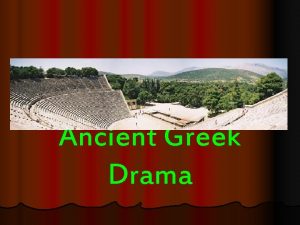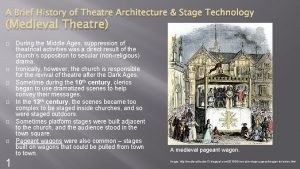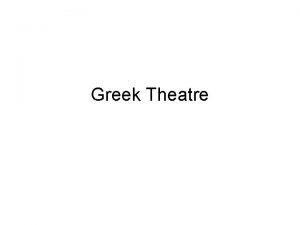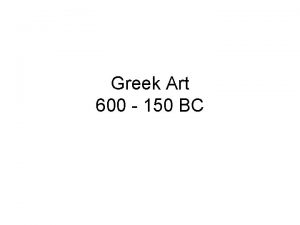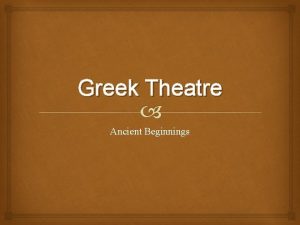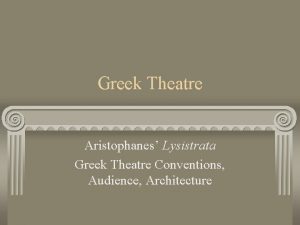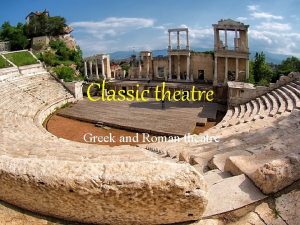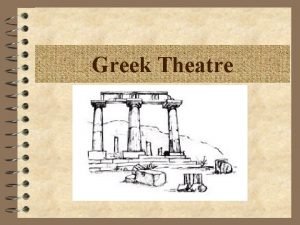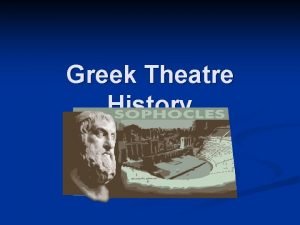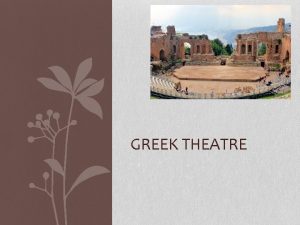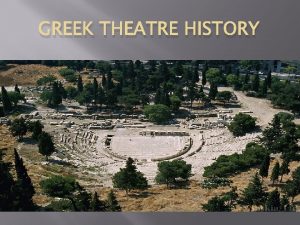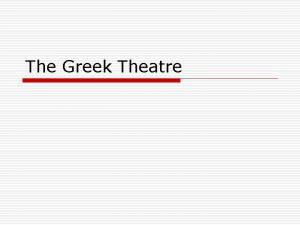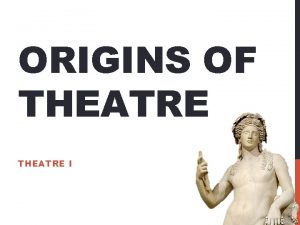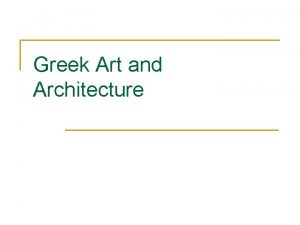Greek Theatre Art Architecture Greek Theatre Origins historians


















- Slides: 18

Greek Theatre, Art & Architecture

Greek Theatre Origins -historians believe that the first theatre started from the ceremonies Greeks attended in honor of Dionysus, the God of fertility/wine. -eventually, theatre attendance became a popular form of entertainment.

Greek Theatre Huge stone auditoriums were built for performances. (some could hold up to 14 000 people) Plays were popular… but throwing food was allowed if you disliked it! All actors were men.

Greek Theatre There were two main types of plays: Tragedy – a play with an unhappy ending. Comedy – a play with a happy/cheerful ending.

Greek Theatre Other words we use in theatre today that comes from Ancient Greece: Orchestra – the place in front of the stage reserved for the chorus. Chorus – the actors who commented on the plot to the audience, they danced while they spoke. Theatron – the place where the audience sat.

Greek Art Greek painters and sculptors showed human beings as beautiful and unflawed. �This reflects the fact that a beautiful body was as important as a beautiful mind. People rarely expressed the extremes of emotion in art.

Greek Art Human figures in Greek art stood or sat in calm and dignified poses. The gods/goddesses were a popular subject.

Greek Art tended to take the following forms. Sculptures Paintings Pottery

Greek Art

Greek Architecture Architects strove for harmony and balance in their work. They applied mathematical laws of proportion to their temples and theaters.

Architecture The Greeks used three styles of columns. Doric Ionic Corinthian

Architecture Doric The style is rather sturdy and its top (the capital), is plain. This style was used in mainland Greece and the colonies in southern Italy and Sicily.

Architecture An example of Doric columns is on the Parthenon – one of the most famous pieces of Greek architecture.

Architecture Ionic The Ionic style is thinner and more elegant. Its capital is decorated with a scroll-like design (a volute). This style was found in eastern Greece and the islands.

Architecture The temple of Athena Nike in Athens.

Architecture Corinthian The Corinthian style is seldom used in the Greek world, but often seen on Roman temples. Its capital is very elaborate and decorated with acanthus leaves.

Architecture The temple of Zeus in Athens.

Architecture You see bits and pieces of Greek architecture in many modern buildings – for example, the White House.
 Cenutar
Cenutar Origins of theatre
Origins of theatre Greek amphitheatres
Greek amphitheatres What is a greek tragedy
What is a greek tragedy How do historians measure time
How do historians measure time Why do historians divide history into eras
Why do historians divide history into eras Lucien febvre
Lucien febvre Most historians agree that military disasters
Most historians agree that military disasters Why do historians organize history chronologically?
Why do historians organize history chronologically? Historians value the writings of ibn battuta because he –
Historians value the writings of ibn battuta because he – Until lions have their historians
Until lions have their historians What do historians call the early period of human history
What do historians call the early period of human history Intentionalist historians
Intentionalist historians When would a historian use a calendar
When would a historian use a calendar Why historians disagree
Why historians disagree Medieval theatre stage
Medieval theatre stage Theatre architecture history
Theatre architecture history Bulgakov
Bulgakov Boleslavsky the first six lessons
Boleslavsky the first six lessons

